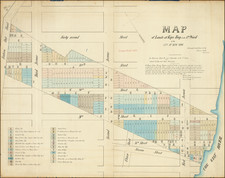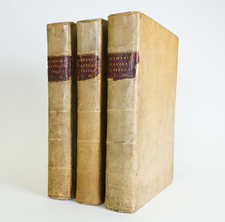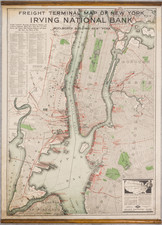Includes Gramercy Park and land once owned by Revolutionary War General Horatio Gates.
This is a John Bute Holmes 1866 cadastral map of parts of the Gramercy, Rose Hill, and Kips Bay neighborhoods in the borough of Manhattan in New York City. The map depicts the city from Fifth Avenue to the East River and from Thirty-First Street to Twentieth Street and Gramercy Park. New York's famous grid system acts as the basis for Holmes's map, with the familiar streets and avenues providing a basis upon which Holmes superimposed the neighborhood's now lost streets and residences. The modern city blocks created by the 1811 Commissioner's Plan are separated into neat lots, all of which are numbered. The older streets, however, and the property lines pay little heed to the organization imposed by the Commissioner's Plan. Allotments and leased plots of land branch out from Bloomingdale Road in the lower left quadrant, where Rose-Hill Street cuts through several of the Commissioner's blocks. Bellevue Hospital is situated on the banks of the East River, as it is today. Older streets, including Cornelius Street, Maria Street, and Eliza Street, are ghosted in over the grid.
Rose Hill Farm
Rose Hill Farm was originally acquired by the Honorable John Watts (1715 - 1789) from James DeLancey (November 27, 1703 - July 30, 1760) in November 1747. Containing over 130 acres, the farm occupied land that today stretches from 21st to 30th Street and from Fourth Avenue to the East River. Watts, a Loyalist, and his family left for Britain in 1775 and left the farm in the hand of his son John Watts Jr (1749 - 1836). The younger Watts eventually inherited the farm and his father's house on Broadway in 1789 after his father's death. The main house on the property burned in 1779 during the British occupation, but a deed records, 'houses, buildings, orchards, and gardens' on the property in the 1780s. Pieces of the farm began to be sold off in the 178s, and the rest of the property listed for sale in 1790. It was acquired by Revolutionary War General Horatio Gates who built a country estate with a mansion at the corner of today's Second Avenue and Twenty-Second Street. When Gates died in 1806, the mansion was turned into a boarding house. What was left of the estate had been divided into lots by the time of the 1811 Commissioner's Plan.
Provenance
This map was acquired as a part of a large collection of New York cadastral maps associated with the layer Ronald K. Brown, a Deed Commissioner operating in the late 19th and early 20th century with an office at 76 Nassau Street, New York - not far from Holmes' own office. Most of the maps in the collection, including the present map, bear Brown's stamp on the verso. The maps were passed to Dominic Anthony Trotta, a real estate agent working under Brown. Brown seems to have ceased business around 1919, but Trotta continued as a real estate agent, becoming a New York Tax Commissioner in 1934 under the Fiorello H. La Guardia administration. The maps remained with Trotta's heirs until our acquisition of the collection.
Publication History and Census
This map was created and published by John Bute Holmes in 1866. Three examples are recorded in the OCLC as being part of the institutional collections at Princeton University, the New York State Library, and Harvard. Although uncatalogued, we believe that the New York Public Library also has an example.
City Surveyor John Bute Holmes (ca.1820-1887) was a compelling figure, as much for his scandalous personal life, as for his ingenious maps.
The details of his early personal life are difficult to trace, partially as he constantly changed his version of his biography. At one point he claimed to have been born on the Island of Mauritius in 1822, and to have moved from there to Cork, Ireland; according to his account, he moved from Cork to the United States in 1838. He held the position of City Surveyor in New York in the 1860s through 1880s and eventually settled on a farm in New Jersey, where he died.
According to the cataloging of Lindsay Turley, of the Museum of the City of New York:
John Bute Holmes was married to at least four women during his life, sued by a fifth for "impeaching her chastity" as a result of "breach of promise of marriage," known to have lived with another "as husband and wife," and was reputed to have killed a policeman with whose wife he was involved. Some of these relationships appear to have overlapped, and most of the wives were unaware of the previous wives, even when the unions had been dissolved legally. It wasn't until Holmes's death in 1887 that the four legal (or at least to their knowledge) wives came face to face in an attempt to claim their inheritance. The dual nature of Holmes's maps strangely seems to reflect the duplicitous nature of Holmes's life...
A few different accounts in the New York Times attempt to sort it out, and briefly, this is what I've come away with:
- Wife # 1: Anna Maria Clear, married Cork Ireland 1838. Holmes left her in 1856, Anna filed for divorce in 1875. One daughter.
- Living as husband and wife: Ida Kerr, dates unknown.
- Wife #2: Hannah Wright Williamson (also his half-sister), marriage date unknown. Three children.
- Sued for breach of marriage promise: May Chamberlayne, 1874.
- Wife#3: Mary Sullivan Browning, marriage date unknown. One son.
- Wife#4: Katie Meadows, married ca. 1886.
See the MCNY blog entry on John Bute Holmes here: https://blog.mcny.org/2014/03/04/john-bute-holmes-surveyor-and-polygamist/
Holmes is thought to have produced a total of 21 maps of between the 1860s and the 1880s. We have not completed a total census of all map titles from Holmes' series, but we have handled over a dozen from one collection only.
"Farm Maps"
Although it is now hard to believe, Manhattan, as recently as the early 19th century, was largely covered in open farmland. As the city rapidly developed during the 19th century, all hints of its previous bucolic state fell away. In the 1860s, this transformation became a fascination for City Surveyor John Bute Holmes (about whom, more later).
Holmes began gathering old surveys and documents that related to Manhattan's previous land use and landowners, transposing new lot and street detail over the previous geography.
There was a long history of mapping Manhattan's farms, both during the actual agricultural era and thereafter. One of the greatest cartographic feats was Randel's Farm Maps which are reminiscent of Holmes' without the "modern" overlay. http://www.mcny.org/content/randel-farm-maps










![(New York City) [Original portrait of an American gentleman with New York City Street Plan]](https://storage.googleapis.com/raremaps/img/small/84607.jpg)

![[Hells Kitchen / Midtown West] Map of the Hermitage Farm and the Norton Estate Compiled From Authentic Data.](https://storage.googleapis.com/raremaps/img/small/61035.jpg)
![Map of the State of New York with Part of Upper Canada [Large inset plan of New York]](https://storage.googleapis.com/raremaps/img/small/91848.jpg)
